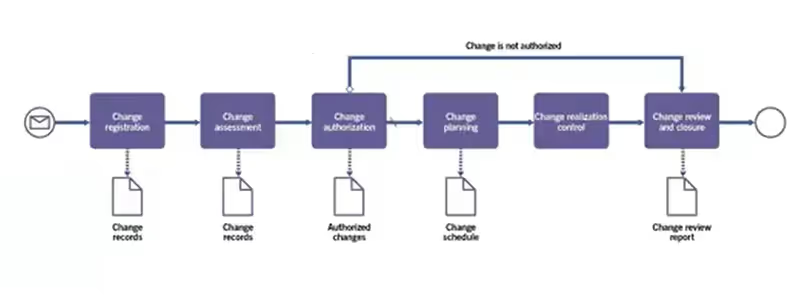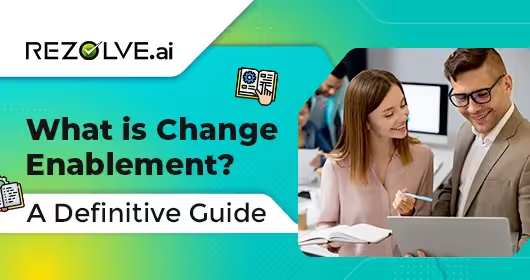The concept of change advisory boards (CABs) emerged as a response to the need for structured oversight and control over organizational changes. Initially, they provided valuable insights and recommendations for proposed changes, serving as a forum for collaboration between IT teams and stakeholders.
Over time, their function shifted towards a more authoritative role, transforming them into approval boards. This transition resulted in rigid processes and bottlenecks, as IT teams spent more time on approvals than effective implementation.
This rigid approach impacted innovation and agility. Recognizing these challenges, ITIL 4 introduced a paradigm shift to change enablement over traditional change management practices.
This article will explain change enablement and how it differs from change management, enabling you to maximize successful service/product change.
What is Change Enablement?
As per Change Enablement ITIL 4 Practice Guide (2020), change enablement is a systematic approach …
“to maximize the number of successful service and product changes by ensuring that risks have been properly assessed, authorizing changes to proceed, and managing the change schedule.”
Change enablement is an extended version of change management. While change management includes the life cycle from identifying the need to training, the enablement approach works on continuous improvement and stakeholder engagement.
Unlike the reactive approach of change management, which only addresses changes when risks arise, change enablement focuses on identifying trends and conducting risk assessments to optimize IT services proactively. By involving stakeholders and users throughout the process, change enablement ensures employee adoption and successful change implementation.
This reactive approach includes both—change lifecycle management and change optimization.

Change lifecycle management represents the entire lifecycle of changes from initiation to closure. It includes submission of change requests, evaluation, approval, scheduling, implementation, and post-implementation reviews.

Meanwhile, change optimization focuses on continuous improvement of the change management process. It aims to enhance efficiency, effectiveness, and alignment with business objectives by analyzing past changes, identifying improvement areas, and implementing best practices.
This approach further separates change management into service request and organizational change management.
Service request management primarily handles user requests for IT services or resources, focusing on meeting needs and ensuring smooth service delivery. On the other hand, organizational change management addresses the human side of organizational change. It includes communication, training, leadership support, and cultural alignment to ensure effective change integration.
Change Enablement vs Change Management
The transition from change management to change enablement aimed to address rising failed change implementation. The table below outlines the difference between the two:

Benefits of Change Enablement
Change enablement transforms organizations' operations, moving from top-down instructions to collaborative teamwork. Involving stakeholders and incorporating user feedback promotes ongoing improvement, creating a strong foundation for successful adoption, sustainable growth, and competitive advantage.
This shift yields several benefits, including:
- Enhance employee experience through active involvement and addressing concerns
- Boost adoption rates by fostering effective communication and stakeholder engagement
- Ensure successful implementation by iteratively improving processes based on user feedback
- Reduce costs by proactively mitigating risks and minimizing rollbacks
- Improve employee engagement by involving them in decision-making
- Promote a culture of innovation and collaboration via open communication
- Mitigate risks and assess impact through thorough analysis
- Minimize disruption by carefully planning and coordinating changes
- Accelerate change implementation through the use of multiple delivery models and automation tools
The 4 Principles of Change Enablement
Broadly, the four principles of change enablement are:
- Communication of the change: Be transparent and share the information regarding the change, its rationale, and its potential impact on stakeholders. This helps manage expectations, reduce uncertainty, and gain buy-in from those affected by the change. Communication channels can include ITSM tools, emails, newsletters, and one-on-one discussions.
- Engagement: Request input, feedback, and participation from individuals and groups affected by the change. This ensures that their perspectives, concerns, and contributions are valued. Organizations increase ownership, commitment, and support for the change initiative by involving them early and throughout the change journey.
- Management and motivation: Effective management includes setting clear objectives, defining roles and responsibilities, and establishing accountability mechanisms. Additionally, motivating stakeholders involves highlighting the benefits of the change, recognizing their contributions, and celebrating milestones to encourage commitment and resilience.
- Coaching: Effective coaching helps individuals develop the skills, knowledge, and mindset needed to adapt to change positively and take on new roles and responsibilities. Coaches can offer one-on-one sessions, group workshops, or informal mentoring to address specific concerns and build confidence.
Change Enablement Roadmap
A change enablement roadmap is a strategic plan outlining all the steps and activities required for successful implementation. It supports change management by facilitating the following:
- A single source of truth: It is a central document that consolidates all information related to the change initiative, ensuring access to accurate and up-to-date information.
- Informed stakeholders: The roadmap communicates key milestones, timelines, and responsibilities to keep stakeholders informed and aligned throughout the change process.
- Resource management: It defines roles, responsibilities, and dependencies, ensuring accountability and effective resource allocation.
- Contextual understanding: It provides context to stakeholders by outlining the rationale, objectives, and expected outcomes of the change initiative, enabling them to understand the significance of the proposed changes within the broader organizational context.
- Customized views for communication: These roadmaps are customizable to different stakeholder groups, making it easier to communicate relevant information to specific audiences.
- Clarity and simplicity for alignment: It presents information in a structured format, enhancing clarity and simplicity, and facilitating alignment and consensus among stakeholders.
How to Get Started With Change Enablement
Here's a step-by-step process to adopt the ITIL 4 change enablement approach:
- Gap analysis: Assess the current change management practices against the principles and concepts outlined in ITIL 4 change enablement. Identify areas where the existing processes align with ITIL 4 and areas that require adaptation.
- Education and training: Educate the team about the key concepts and principles of ITIL 4 change enablement, such as agile change management, stakeholder engagement, and value co-creation.
- Stakeholder engagement: Engage stakeholders to gather input and insights on their expectations and requirements for change management. Encourage active participation and collaboration to ensure alignment with business objectives.
- Process redesign: Based on the gap analysis and stakeholder feedback, redesign change management processes to align with ITIL 4 change enablement principles. This involves revising workflows, roles and responsibilities, and decision-making frameworks.
- Agile implementation: Implement changes incrementally and iteratively, following agile principles. Start with pilot projects or small-scale changes to test the new processes and gather feedback for continuous improvement, preferably with a specific business unit or project team, before rolling them out organization-wide.
- Communication and change management: Communicate the changes to all stakeholders, emphasizing the benefits and rationale behind adopting the ITIL 4 change enablement approach. Provide support and resources to facilitate the transition, addressing any concerns or resistance.
- Measurement and evaluation: Establish KPIs to measure the effectiveness of the new change management processes. Monitor these performance metrics, such as change success rate, time to implement changes, and customer satisfaction, to assess progress and identify areas for further improvement.
- Continuous improvement: Regularly review and refine the change management process to promote a culture of continuous improvement. Encourage stakeholders and employees to provide feedback and identify opportunities for optimization and innovation.
How ITSM Tools Help With Change Enablement
ITSM tools support change enablement by offering a suite of functionalities to facilitate seamless change management processes:
- Workflow integration: ITSM tools connect incident reports, problem resolutions, and change requests. For example, when multiple incidents point to the same underlying problem, the ITSM tool prompts a change to address the root cause.
- Native capabilities: Instead of using separate tools for different tasks, which leads to confusion, duplication, and errors, an ITSM tool provides a single platform to manage everything from incident tracking to change implementation, saving time and reducing complexity.
- Automated tasks: The ITSM tool automates routine tasks, such as sending alerts when a change request is approved or assigning tasks to team members. For instance, when a change request is submitted, the tool automatically directs it to the appropriate team member based on predefined rules.
- Enhanced collaboration: Integration with platforms like Slack or MS Teams enhances collaboration among team members. End users can use Slack channels to discuss change requests, share updates, and coordinate tasks in real-time.
- Enhanced decision-making with risk assessment tools: The ITSM tool enables risk assessment to evaluate the potential impact of changes before implementing a change. For instance, it assesses potential risks for a major system upgrade, such as downtime or data loss, and develops mitigation strategies accordingly.
- Continuous improvement: The ITSM tool analyzes performance metrics and trends to identify areas for improvement. For example, data on change success rates and implementation times highlights bottlenecks and opportunities to optimize change management processes over time.
- Multiple change delivery options: The ITSM tools support various change approaches and delivery options. For instance, automated handling of Level 1 requests and allocating unresolved issues to the right agent based on incident prioritization. Some tools even leverage generative AI to resolve issues with no-agent contact, further enhancing efficiency automatically. These options allow a flexible approach to different changes and optimize resources.
Change Enablement With Rezolve.ai
Rezolve.ai takes ITSM up a notch with generative AI and automation capabilities to support your change enablement initiatives.
- Centralized management: It brings all the change management tasks on a centralized interface and integrates seamlessly with MS Teams, ensuring all stakeholders have all the necessary information and resources in one place.
- Automatic approvals: It automates approval processes to speed up change implementation and reduce manual effort without compromising compliance with organizational policies.
- Real-time tracking and reporting: It offers transparency and visibility into change activities with its real-time reporting and tracking functionality to engage stakeholders and enable informed decision-making.
- Compliance and risk management: It helps organizations manage compliance reporting and reduce risks associated with changes, ensuring secure and compliant implementation.
- Insights-driven change management: With generative AI capabilities, it continuously monitors change implementation, providing insights for potential risk or optimization of change practices.
Overall, Rezolve.ai creates a conducive environment for bringing all the stakeholders and end users together on a centralized platform and continuously improving change processes. Its generative AI capabilities transcend tool functionality, making it a catalyst for change enablement.
Frequently Asked Questions (FAQs)
What is a change enablement lead?
A change enablement lead is a person responsible for overseeing change management—the planning, execution, and communication of changes within an organization. They ensure smooth transitions by managing risks, promoting a culture of continuous improvement, and engaging stakeholders.
What is change enablement in ITIL4?
Change enablement in ITIL4 refers to the systematic approach of managing changes to IT services in a controlled manner to maximize successful change implementations and minimize disruption, ensuring alignment with business objectives.
What is the change enablement approach?
The change enablement approach involves systematic planning, communicating, and implementing changes in IT systems to minimize risks, engage stakeholders, and promote continuous improvement through structured processes and feedback mechanisms.





.webp)




.jpg)

.png)








.png)